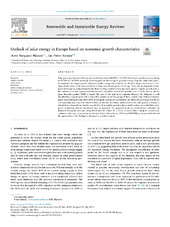Outlook of solar energy in Europe based on economic growth characteristics
Peer reviewed, Journal article
Published version

Åpne
Permanent lenke
https://hdl.handle.net/1956/23303Utgivelsesdato
2019Metadata
Vis full innførselSamlinger
Originalversjon
https://doi.org/10.1016/j.rser.2019.109306Sammendrag
Solar power production in Europe has raised from about 130 MW to 110 GW of installed capacity (corresponding to 90 GWh to 120 TWh in annual electricity generation) during the present century. Together with wind power, it constitutes the largest growth within renewable energy sources in the last decades. At present however, clear signs of saturation can be observed in the leading areas of solar power in Europe. Here, the development of solar power in Europe is analysed and, for the three leading countries (Germany, Italy, Spain) a logistic growth path at the national level and a proportionality between saturation level of the growth curve of each country and its gross domestic product (GDP) is found. The sum of the next three countries (France, UK, Belgium) is well described by a logistic path with a time offset relative to the first group of three, and the sum of the two logistic paths, representing in total about 85% of European solar power production, describes the growth pattern in the corresponding area very well. Based on this, an estimate of a future saturation level for solar power in Europe is obtained by extrapolation. Finally, a model based on logistic growth patterns and learning curves that links solar power production data to investment data, is proposed. The proposed model is validated and calibrated on historical European data and extrapolated into the future. In a future scenario where European investments continue to decrease, a saturation level that is fully in line with our GDP based 200 TWh/y estimate is found and the application of the findings is discussed in a global context.
